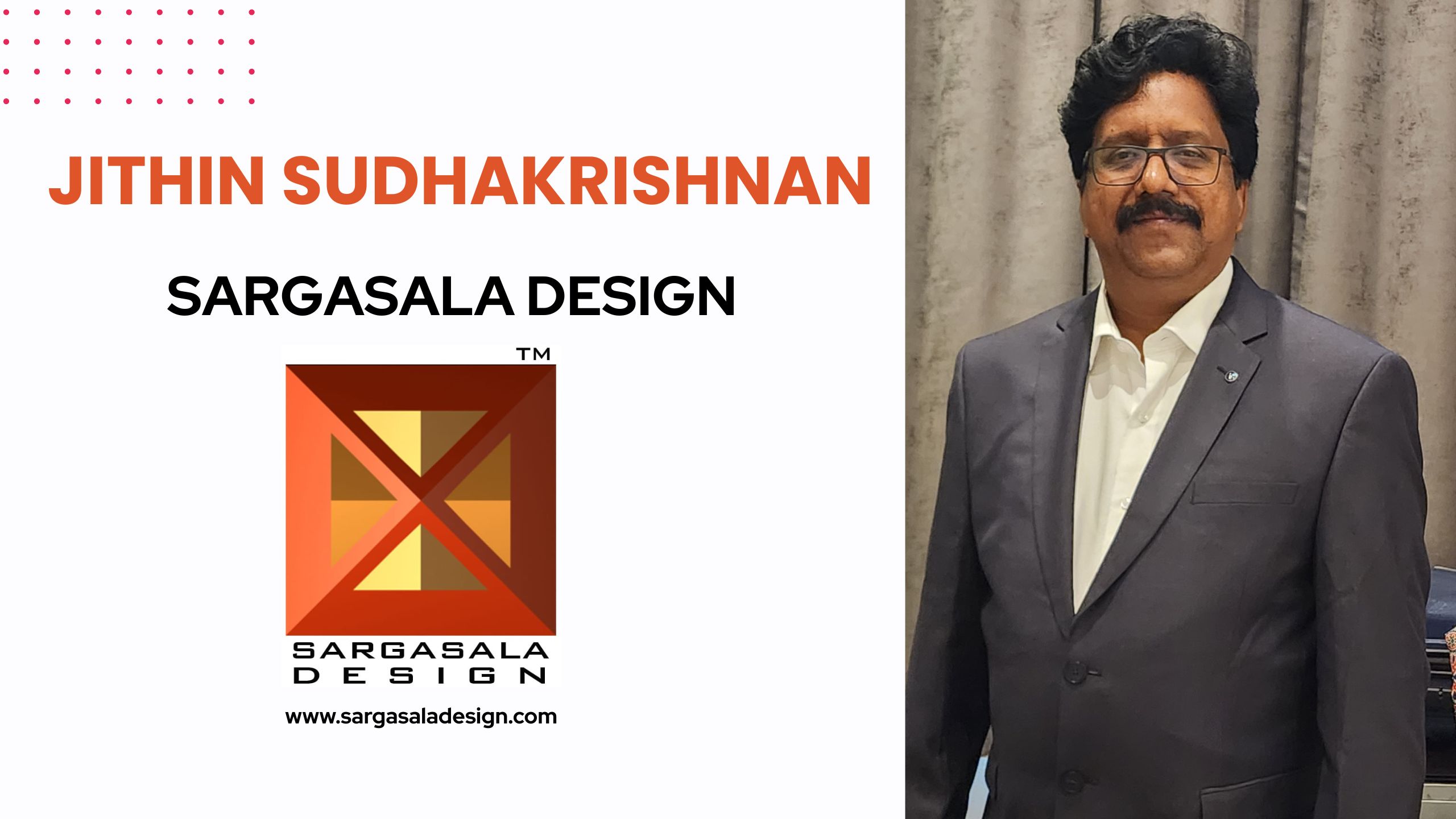Founded by Jithin Sudhakrishnan, Sargasala Design has grown to become a leading name in the world of traditional Kerala architecture, eco-friendly design, and heritage conservation. From its humble beginnings in 2000, Sargasala Design has successfully combined traditional principles with modern-day innovation, creating architectural marvels that reflect the rich cultural heritage of India while embracing sustainable and eco-conscious building practices. This success story explores the journey, challenges, and triumphs of Jithin Sudhakrishnan and his firm, Sargasala Design, in reshaping the future of architecture.
Early Life and Inspiration
Jithin Sudhakrishnan’s passion for architecture began at an early age, shaped by his fascination with the traditional Kerala-style houses and heritage structures that dotted his surroundings. Armed with a deep-seated love for his culture and an unyielding desire to contribute meaningfully to his field, Jithin pursued his education with a focus on architecture and structural engineering.
Jithin’s academic qualifications include an M-Tech in Structural Engineering and Construction Management from APJ Abdul Kalam Technological University, a B-Tech in Civil Engineering (with a specialization in Habitat Engineering and Construction Management) from Cochin University of Science and Technology, and a Diploma in Traditional Architecture from Vasthuvidya Gurukulam, Department of Culture Kerala. His journey as an architect was further propelled by his involvement in the Muziris Heritage Project, one of India’s largest and most significant heritage conservation initiatives.
His inspirations, Dr. APJ Abdul Kalam and Dr. E. Sreedharan, helped shape his professional journey, motivating him with their vision, humility, and dedication. The values instilled by these icons would go on to influence Jithin’s approach to architecture, particularly his focus on blending innovation with tradition and sustainability.
The Birth of Sargasala Design
In 2000, Jithin founded Sargasala Design, with a vision to provide high-quality architectural services rooted in traditional Kerala architecture while promoting sustainability and energy-efficient practices. His vision was not just to design buildings but to create spaces that harmonize with nature, promote cultural heritage, and respect environmental responsibility.
Sargasala Design quickly made its mark with its distinctive approach that combines the best of both worlds – traditional aesthetics and modern functionality. Whether working on conservation projects, residential villas, or eco-tourism ventures, Jithin’s approach has always been rooted in a deep understanding of the cultural and environmental significance of every design.
A Unique Approach to Architecture: Sustainable & Eco-Friendly Design
At the heart of Sargasala Design’s work lies the commitment to sustainability. As a Building Energy Efficiency Expert empanelled by the Energy Management Centre Kerala, Jithin ensures that all the firm’s projects are designed with the goal of reducing energy consumption and minimizing environmental impact. Sargasala Design’s portfolio includes numerous sustainable and eco-friendly buildings, including residential, commercial, and heritage projects.
Jithin has been an advocate of the Indian government’s net-zero carbon emission goal for 2070 and ensures that all projects contribute to this vision through energy-efficient design and construction practices. A prime example of this is Neelambari, an eco-tourism project located in Arattupuzha, Kerala, which employs sustainable design strategies such as rainwater harvesting, bamboo planks for foundation reinforcement, and the use of locally sourced materials. The project also integrates the local community, providing employment opportunities for socially and economically disadvantaged groups.
The Neelambari resort embodies Jithin’s belief that architecture should not only preserve culture but should also foster sustainable development and community engagement. The resort features a traditional Kerala style design that echoes grandeur and history while ensuring modern comforts. The integration of passive design strategies, like optimal orientation and natural ventilation, further aligns the project with the principles of sustainability.
Overcoming Challenges and Embracing Opportunities
Like many entrepreneurs, Jithin faced significant hurdles in the early stages of his career. Securing funding was perhaps the biggest challenge, along with gaining recognition in a highly competitive industry. However, Jithin’s commitment to his craft and his transparent, approachable business philosophy helped Sargasala Design gradually earn the trust and respect of clients and peers alike.
The real test came after the onset of the COVID-19 pandemic. Like many businesses, Sargasala Design experienced a slowdown in project work. The shift to digital platforms and a lack of skilled engineers and laborers in the construction industry compounded the challenges. However, Jithin’s innovative spirit led him to adapt quickly. Through his involvement with LENSFED (a trade union of licensed civil engineers in Kerala), he helped establish a Skill Park to bridge the skills gap in the industry. This initiative helped mitigate the shortage of skilled labor and provided essential training to aspiring engineers and construction workers.
Jithin’s ability to adapt and innovate in the face of adversity is one of the key factors that has contributed to his continued success. His focus on networking, cultivating strong relationships, and keeping up with industry trends—such as the rise of digital tools in architecture—has allowed Sargasala Design to stay ahead of the curve.
Major Projects and Contributions to Society
Throughout its journey, Sargasala Design has been involved in several significant projects that have not only contributed to the architectural landscape of Kerala but have also had a positive impact on society. One such project is the Kodungallur Temple Museum, a conservation initiative that reflects Jithin’s expertise in restoring heritage structures while maintaining their cultural integrity.
Sargasala Design has also worked on numerous projects for Guruvayur Devaswom, Vadayar Samooham Auditorium, and Kerala Judicial Academy, among others. These projects showcase the firm’s versatility and ability to work across different sectors while maintaining high standards of design and sustainability.
The firm’s dedication to affordable housing is another area where Jithin and his team have made a tangible impact. Through their work with PMAY (Pradhan Mantri Awas Yojana) and Life Mission Projects, Sargasala Design has been able to provide safe and sustainable housing solutions for underprivileged communities in Kerala. By incorporating affordable technology and materials, they’ve been able to address the housing challenges faced by many people in the region.
The Future of Sargasala Design
Looking ahead, Jithin envisions Sargasala Design as a leader in promoting smart and intelligent buildings. He aims to break away from conventional methods of construction by integrating emerging technologies such as 3D concrete printing and low-cost, lean construction techniques. His focus is on making buildings that are not just energy-efficient but also adaptive to future needs, creating spaces that are sustainable, functional, and forward-thinking.
Sargasala Design’s future is rooted in the principles of innovation, sustainability, and community engagement. The firm’s work continues to support India’s goal of achieving net-zero carbon emissions by 2070, with an emphasis on smart buildings, energy efficiency, and sustainable architecture. By promoting green practices and incorporating AI and other advanced technologies, Jithin aims to further revolutionize the construction industry.
Lessons Learned and Words of Wisdom
Jithin’s entrepreneurial journey has taught him many valuable lessons. One of the most important lessons he shares is the importance of continuous learning. “The world is changing every moment. Stay updated on the latest developments in architecture, engineering, and building technology. Simplify the job through proper delegation and coordination. Learn from failures, and success will follow,” says Jithin.
For budding architects and designers, Jithin advises them to prioritize sustainable architecture, ethical practices, and green construction methods. He encourages young professionals to never lose sight of the basics—passive design strategies, natural ventilation, and energy-efficient systems are crucial elements that every architect should consider. By adopting smart technologies and focusing on disaster-resilient structures, future architects can create buildings that stand the test of time.





